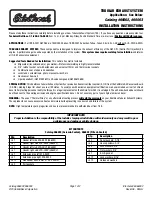
4 Depress the retaining clip and disconnect
the wiring connector from the module.
5 Make a note of the correct fitted positions
of the HT leads then disconnect them from
the module terminals (see illustration).
6 Undo the four retaining screws securing the
module to its mounting bracket and remove it
from the engine.
Refitting
7 Refitting is a reversal of removal.
7
Timing plate (breakerless
ignition systems) -
adjustment
2
Note: Timing plate adjustment is only possible
on models fitted with XV, XW and XY series
engines. Peugeot special tool 80133 or a
suitable alternative will be required for the
adjustment procedure.
1 The timing plate which is located in the
aperture under the plastic cover at the top of
the flywheel housing can be moved within the
limits of its elongated slot (see illustration).
2 The plate is set during production and
should not be disturbed unless a new
flywheel, flywheel housing or other associated
components have been fitted.
3 To adjust the timing plate, carry out the
following operations.
4 Remove the plastic cover.
5 Using the crankshaft pulley nut, turn the
crankshaft until the mark on the flywheel is at
the start of the timing plate.
6 Remove the plug from behind the
crankshaft pulley using an Allen key. Note that
if the hole in the pulley is not over the plug, the
crankshaft should be turned exactly half a
turn. This is because there are two
diametrically opposite timing marks on the
flywheel, and the mark corresponding to TDC
on No 2 and 3 cylinders must be used to bring
the slot in the crankshaft counterbalance in
line with the plug hole.
7 Insert the crankshaft locking tool (Peugeot
special tool 80133) into the plug hole and turn
the crankshaft until the tool is felt to drop into
the cut-out in the counterbalance weight of
the crankshaft.
8 If the special tool is not available, a suitable
alternative can be used (see Tool Tip).
9 With the tool or dowel rod inserted, pistons
2 and 3 are now located at TDC.
10 Release the timing plate bolt and move
the plate to align the flywheel, and 0 (TDC)
mark on the plate. Tighten the bolt to the
specified torque. Apply a blob of paint on the
edge of the bolt so that any subsequent
movement can be recognised.
11 Withdraw the tool, fit a new sealing ring to
the plug and tighten securely.
8
Ignition timing - checking and
adjustment
2
Note: On engines equipped with MMFD
Mono-point G5/6 or Motronic M1.3 engine
management systems the ignition timing is
controlled by the system ECU and cannot be
adjusted.
XV, XW and XY series engines
1 To set the ignition timing statically so that
the engine can be started first remove No 2
spark plug and turn the engine in the normal
rotational direction until pressure is felt -
indicating that the piston is commencing the
compression stroke. The pressure can be felt
using a suitable wooden rod or a piece of cork
placed over the spark plug hole.
2 Remove the plastic cover from the timing
aperture then continue turning the crankshaft
until the mark on the flywheel is opposite the
BTDC mark on the timing plate (see
illustration).
3 Check that the distributor rotor arm is
facing the No 2 HT lead segment position in
the distributor cap. To do this, remove the cap
and mark the outside in line with the segment,
then put it back on the distributor noting
which way the rotor arm is facing.
4 If necessary, loosen the mounting nuts and
turn the distributor body to bring the segment
and rotor arm in line, then tighten the nuts.
Refit No 2 spark plug.
5 Run the engine to normal operating
temperature then stop it and connect a
tachometer and stroboscopic timing light as
described in the instrument manufacturer’s
instructions. If the HT pick-up lead of the
timing light is connected to the HT lead on the
ignition coil it is possible to detect any
discrepancy between the firing of Nos 1 and 4
and Nos 2 and 3 cylinders since there are two
diametrically opposite timing marks on the
flywheel. However, the pick-up lead may be
connected to any one of the spark plug HT
leads, in which case only one of the flywheel
timing marks will be used.
6 Disconnect and plug the vacuum pipe at
the distributor vacuum advance unit.
7 Run the engine at the specified speed and
point the timing light into the timing aperture.
The single mark on the flywheel should be
aligned with the BTDC mark on the timing
plate (see illustration). If the ignition coil HT
lead has been used (see paragraph 5), and
there is wear in the distributor, there will be
two marks visible on the flywheel close to
each other. In this case the mid-point
between the two marks should be aligned
with the BTDC mark on the timing plate.
8 If adjustment is necessary, loosen the
distributor mounting nuts and rotate the
distributor body as required. Tighten the nuts
on completion.
9 The operation of the centrifugal advance
weights in the distributor can be checked by
increasing the engine speed with the timing
light pointing in the timing aperture and
observing that the mark on the flywheel
advances from its initial position.
Ignition system 5B•5
5B
7.1 Timing plate components on XV, XW
and XY series engines
1 Diagnostic socket
2 Cover
3 Timing plate
8.2 Timing plate marks on XV, XW and XY
series engines
8.7 Ignition timing adjustment on XV, XW
and XY series engines
A Using spark plug HT lead
B Using ignition coil HT lead
A crankshaft locking tool can be made
from a 100 mm length of 8.0 mm dowel
rod.
Summary of Contents for 205 Cabriolet
Page 108: ...4B 8 Notes ...
Page 114: ...4C 6 Notes ...
Page 132: ...5B 8 Notes ...
Page 148: ...9 16 Notes ...
Page 160: ...10 12 Notes ...
Page 174: ...11 14 Notes ...
Page 189: ...Wiring diagrams 12 15 12 Key to wiring diagrams ...
Page 190: ...12 16 Wiring diagrams Key to wiring diagrams continued ...
Page 230: ...REF 29 REF Notes ...
Page 231: ...Left blank for manual listing pages ...
















































